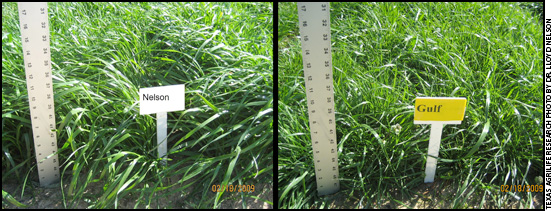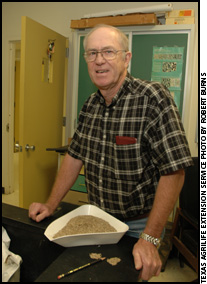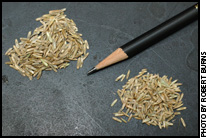
Pictures taken of Nelson ryegrass and the more commonly used Gulf ryegrass taken on the same day in test plots at the same site. The newly released Nelson ryegrass yielded 2,000 pounds more per acre in many tests.
Nelson Ryegrass Outyields Gulf
The newly released ryegrass outyields TAM 90 and Prine, as well.
Pinching pennies when buying ryegrass seed for winter grazing is a bad business decision, says a Texas AgriLife Research scientist.

Dr. Lloyd Nelson, the developer of the newly released Nelson ryegrass, is known for his TAM 90 and TAMTBO ryegrasses, as well as his dwarf turfgrasses, such as Panterra and Axcella.
"Nelson" is a newly released ryegrass developed by Lloyd Nelson, AgriLife Research small-grains breeder. It has a higher yield potential than "primo" ryegrasses such as TAM 90, Prine and Jumbo, he says.
"And in South Texas, it’s higher than Marshall. In more northern areas, it’s not significantly higher than Marshall, but it's competitive," says Nelson, who also developed TAM 90 and TAMTBO, other high-yielding ryegrasses.
However, despite the yield advantages, the most commonly planted ryegrass variety for winter pastures is probably Gulf. Why? Probably because its seed is cheaper, he says.
"Gulf costs about 34¢ to 36¢ a pound, while newer varieties like Nelson, Prine and TAMTBO are about 45¢ to 48¢ per pound," he explains.
At the recommended planting rates of 20-25 pounds (lb.) per acre, farmers will save about $3 per acre in seed costs, Nelson says. "But, for that $3 savings, they will typically give up about 2,000 pounds of high-quality forage per acre."
That 2,000 lb. is the equivalent of at least two large round bales of hay per acre, which typically would be sell for $40 or more each, he adds. "It's not a good business decision, in my opinion, to scrimp on seed costs."
Nelson ryegrass has been 10 years in development, Nelson shares. Where it was tested in heavy gumbo soils near College Station and in the Beaumont area, it averaged about 7,000 lb. of forage per acre. In comparison, Prine ryegrass averaged about 6,000 lb.; TAM 90 about 5,900 lb.; and Gulf about 5,500 lb.
In 2009-2010 at the College Station site alone, Nelson ryegrass produced 12,500 lb. Neslon notes the new variety still outperformed Gulf by nearly 2,500 lb.
Nelson ryegrass' three-year average yields in East Texas at the Texas AgriLife Research and Extension Center in Overton, where the soils are sandy loams, topped 9,500 lb. Gulf produced 8,300 lb. at the Overton site, while Prine and Passerel Plus ryegrasses produced 9,270 lb. and 9,160 lb., respectively, Nelson says.
Nelson ryegrass is a tetraploid, which means it has double the number of chromosomes as many ryegrasses. TAM 90 and Marshall ryegrasses have 14 chromosomes. Nelson, TAMTBO and Prine, all tetraploids, have 28, Nelson explains.

Nelson ryegrass is a tetraploid, which means it has 28 chromosomes, double the number of many ryegrasses. Because it is a tetraploid, the seed of Nelson ryegrass, (upper left) is larger than the seed of Gulf ryegrass, which only has 14 chromosomes.
Being a tetraploid means a plant's cells must be larger to accommodate the increased number of chromosomes. Tetraploids have bigger leaves and larger seeds, but not necessarily higher yields, says Nelson.
Larger seeds means a fewer number of seeds are planted per acre per pound of seed, but in the case of Nelson ryegrass, the increased plant and leaf size compensates, he says. "I ran seedling rate tests and found no advantage to planting Nelson at a higher rate."
He says there's still plenty of time to meet the ryegrass planting window for Texas, which is from mid-October through the first week of December. However, as with all ryegrasses, Nelson ryegrass will need adequate soil moisture to emerge. Ryegrass is typically overseeded over existing, dormant warm-season grass pastures after a light disking.
All ryegrasses, whether a new variety like Nelson or an older variety such as Gulf, will need to be fertilized to soil tests. Usually this means 100 lb.-150 lb. of actual nitrogen during the season, Nelson says.
Because of high nitrogen costs, farmers may try to grow ryegrass for winter pastures at a reduced nitrogen rate or not fertilize at all. This is another bad business decision, Nelson says. "If they're not going to fertilize, I wouldn't recommend them planting any ryegrass. Just buy the hay."
Editor's Note: Nelson ryegrass is marketed by BWI Cos. Sales representatives may be reached at 800-752-6632 or 800-442-8443.





